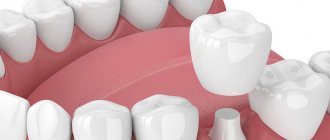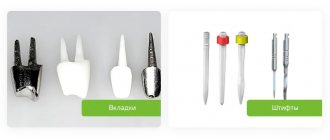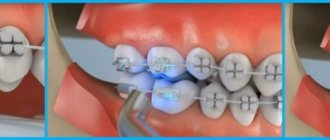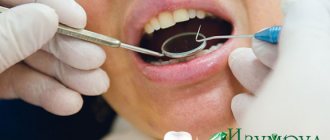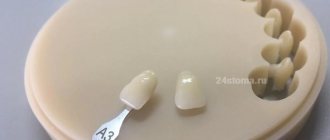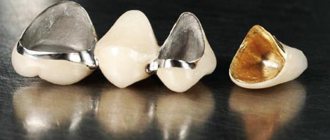Features of a temporary crown on an implant
After implantation, a certain period of time must pass before the permanent crown is placed. Over the course of several months, a specialist monitors the osseointegration of the titanium screw. But walking even for several days with a “space” instead of a tooth is extremely uncomfortable. A temporary crown on an implant made of composite material or plastic will help solve the problem. The design does not interfere with the process of engraftment of the artificial root and creates the necessary load for primary stabilization. Due to the fact that special cement dissolves over time under the influence of salivary enzymes, the temporary crown can easily be replaced with a permanent one at the right time.
What are temporary crowns on implants used for?
In addition to maintaining the aesthetics of your smile, temporary crowns placed on titanium roots perform a number of other useful tasks.
- Preparation of soft tissues for the next stage of implantation.
- Providing psychological comfort.
- Helps in the formation of smooth gum edges.
- Protection against bacteria that can cause gum inflammation and implant rejection.
- Maintaining correct diction and bite.
- Restoration of chewing functions.
- Facilitate adaptation to permanent crowns.
- Creating the correct load to stabilize the implant.
Shaping the gum contour using temporary crowns
With one-stage dental implantation, when a tooth is removed and an implant is immediately installed in its place, a temporary crown (if it can be installed immediately) allows you to preserve the natural contour of the gum around the tooth, preventing the gum from filling the tooth socket.
If it was not possible to immediately install a temporary crown on a dental implant, and the gums have leveled out during the healing of the implant, then temporary crowns help form the correct gingival contour. Let's take a closer look at how this happens.
After the implants have healed, gum formers are screwed into them, which allow access to the implant to be created (sometimes gum formers are installed at the time of dental implantation).
Result after removal of the gum former:
The crown in the lower part has the shape of a cone, so with a special drill or laser the hole from above is expanded to give it a cone-shaped shape, like natural teeth. The expansion is performed under local anesthesia. The advantage of using a laser is that the vessels are immediately sealed and this operation is practically bloodless.
Temporary crowns for implants are made by an orthopedic dentist on the day of the patient’s visit using wax models prepared in advance in the laboratory. A temporary abutment (crown base) is screwed into the implant, and temporary crowns are fixed onto the abutment using temporary cement.
While wearing temporary crowns (about 2 weeks), the gums heal and finally take the desired shape, not only around the crown, but also filling the interdental space (gingival papillae are formed).
Temporary crowns are easily removed, since the fixing composition is not strong (this was done specifically so that the temporary crown can be removed without damaging the implant). If the crown falls off ahead of time, then it must be fixed in place as quickly as possible so as not to disturb the healing of the gums.
Having removed the temporary crowns after 2 weeks, the doctor sees a well-formed bed:
Impressions can now be taken to make permanent crowns that will look perfect from all angles.
While the permanent crowns are being manufactured, temporary crowns are re-installed on the implants.
After the permanent abutments and crowns are made, the temporary structures are removed and the permanent crowns are fixed onto the implants. Thanks to the preparation of the gums, permanent crowns look absolutely natural from all sides.
Without preliminary preparation of the gums, black triangles remain between the teeth, and food gets clogged between the teeth.
Thus, temporary crowns are necessary to create tight contact between the gum and the crown on the implant, which ensures not only aesthetics, but also the health of the gums and the ease of use of the crowns.
Materials from which structures are made
Stamped factory products are created primarily from titanium and plastic (the latter for temporary prosthetics). But today, an increasing number of manufacturers offer not only titanium abutments for permanent prosthetics, but also standard options made of zirconium dioxide - after all, company representatives understand how important not only the functional, but also the aesthetic component of artificial teeth is.
Interesting fact! According to an independent study conducted by a group of scientists in 2012, all-zirconia abutments in combination with titanium roots are subject to higher wear and may even cause prosthetic failure, leading to the need to remove the implants themselves[2].
Some manufacturers also have the ability to supply standard products from different materials: for example, Straumann has options from an alloy of titanium and zirconium, NeoBiotech (Korea) has designs from an alloy of cobalt, chromium and molybdenum.
As for individual models, they can be created from materials such as gold, ceramics, glass ceramics. For example, the line includes the Abutment GoldAdapt series in gold alloy, which feature a burn-out cylinder for creating custom designs through wax-up. Also, for individual systems, the material can be combined - that is, it can consist of components made from various materials, for example, titanium and zirconium dioxide, titanium-aluminum-niobium (Straumann).
How long can temporary crowns be worn?
Typically, temporary crowns are worn for no more than 2 months. Temporary crowns are made from plastic or composite polymers. These materials are quite porous and not very durable. Long-term wearing of temporary dental crowns is not recommended due to the strong accumulation of bacteria on the surface of the crown, which causes inflammation of the gums, as well as increased abrasion of the material.
Plastic temporary crowns can change color due to the use of coloring products - tea, coffee, red wine, etc.
Temporary crowns that will be worn for longer than 2 months are made from more durable materials.
Methods of fixation on dental implants
Screw fastening
The crown is attached using a small retaining screw that is threaded through a hole created on the occlusal surface of the denture. The screw passes through the crown, through the abutment (which also has a hole), and is screwed into a special thread located inside the implant. This is how the final fixation of the external and intraosseous components of the denture occurs. And in order to solve the issue of aesthetics and hide the “tops” of the screws from prying eyes, doctors mask the chewing surface of artificial teeth with a composite material.
Straight or angular superstructures are used for this purpose. The advantage of screw fastening is the ability to remove the structure for its restoration. But screws can break, for example, due to poor-quality material or due to the lack of professionalism of the implantologist. The method is used for single restorations and complex solutions for restoring a large number of teeth using immediate loading protocols.
Cement fixation
The prosthesis is fixed using a special cementing solution and it is no longer possible to remove it - here you will only have to saw the structure (the implants, of course, remain in place). The advantage of cementing is improving the aesthetic qualities and increasing the operating comfort of the structure. It is mainly used for single restorations, less often for complex implantation (but mainly for permanent prosthetics, when there is no need to correct the installed orthopedic structure).
Cost of superstructures from popular manufacturers
As a rule, supporting structures are produced by the same companies that manufacture implants. Well-known brands include Nobel Biocare, Straumann, Osstem, Oneway Biomed, Astra Tech, MIS.
The price of the product depends on many factors - material, shape, type, manufacturer's brand - and starts from 2 thousand rubles for a plastic temporary structure. The cost of structures made in the laboratory according to individual orders is 2–4 times higher than factory ones and amounts to 12–18 thousand rubles. The most expensive are individual elements made of zirconium dioxide, the cost of which exceeds 30 thousand rubles.
However, the cost is actually not important for the patient - when voicing the price for implantation, the doctor immediately includes the cost of the abutment and all other elements in the surgical or orthopedic stage. But it is important for the patient himself to clarify which abutment will be installed - the original one from the manufacturer, an individual one or an analogue.
How to choose the right model
The types of implantological products produced today must be selected individually for each clinical case. The doctor makes a choice based on the characteristics and type of bite of the patient, the thickness of the oral mucosa and its initial condition, and the space between the teeth. It is also necessary to take into account the angle of inclination between all elements of the implantation system and the method of their connection.
The level of aesthetics that needs to be achieved also plays an important role here. For example, in the smile area, the beauty and naturalness of new teeth will be of great importance, but in the chewing area, it is necessary to pay attention to the wear resistance, tightness and strength of the entire prosthetic system, which is achieved, among other things, with the help of a properly selected supporting component.
“Several years ago I got into an accident and was left without two upper teeth. I absolutely did not want to build bridges, because... I already had an unpleasant experience with them, and I didn’t want to spoil the neighboring teeth. I decided to get implants. When the crowns were put on, I didn’t even realize at first that it was a prosthesis. They look like my own. It turned out great."
Mikhail O., from a review from otzovik.com
Maintenance of the temporary structure
Artificial teeth require regular, careful care. If hygiene measures are neglected, plaque will accumulate under the dentures, causing bad breath and provoking the development of caries. In addition, inflammatory dental diseases can develop in the gum tissue. This will cause pain and swelling.
The main area on dentures that requires careful hygiene is located at the junction of the structure with natural teeth. You should also pay attention to the bottom of artificial crowns. Plaque accumulates especially heavily in these areas, so they should be cleaned with a toothbrush with medium-hard bristles, holding the brush at a 45-degree angle.
After each meal, it is necessary to rinse the mouth and brush your teeth using dental floss using gentle, smooth movements. For rinsing, you can use herbal decoctions or ready-made rinses.
It is recommended to periodically place the prosthesis in a special solution. The liquid can be prepared using denture tablets, which can be purchased at a pharmacy. Popular brands of such tablets are Protefix or Corega. After each use of the solution, it should be replaced.
In addition to recommendations for hygiene of temporary structures, you should adhere to the following tips:
- Avoid eating too hard foods (nuts, crackers, etc.).
- Try to chew food on the side of the jaw that is located opposite the denture.
Care instructions
The entire process of dental restoration using the implantation method, starting with implant placement and ending with crown installation, requires careful attention on the part of the patient. It is important not only to see a doctor, but also to take independent care of your oral health.
After fixing the temporary abutment, you must not:
- smoke;
- eat and drink during the first two hours;
- While the wound is healing, it is necessary to eat soft food, not very hot;
- clean the abutment carefully, avoid direct contact with the bristles of the toothbrush;
- rinse your mouth with antiseptic solutions;
- For minor bleeding and swelling, cold compresses can be applied.
Do not hesitate to ask your doctor any questions you may have. It is better to ask several times than to do it wrong and harm yourself.
What is an abutment
Previously, in dentistry, an abutment was called a supporting structure for bridges. Nowadays this word refers to a small rod that plays an important role as the periosteal element of the implant. A replacement structure for lost teeth is installed on it. The following may serve in this capacity:
- one crown;
- bridge prosthesis;
- removable denture.
That is, the abutment serves as a kind of substitute for an artificial root, twisting on one side into an implant, and on the other into a single dental prosthesis or bridge.
Abutments differ not only in size, but also in the material from which they are made, as well as in shape. Which design is best for a patient will depend on a number of factors and clinical considerations.
For reliable and long-term wearing of artificial teeth, the dentist installs an abutment that matches the characteristics of the implant.
How much does it cost on average in Moscow?
| Name of service | Cost, rub. |
| Installation of the healing abutment | 3700 |
| Installation of a temporary abutment | |
| Standard | 4600 |
| Individual | 9400 |
| Temporary abutment by manufacturer (without dental services) | |
| Implantium | 1000 |
| Alpha Bio | 1050 |
| BioHorizons | 1050 |
| M.I.S. | 1400 |
| Osstem | 1800 |
| Xive | 1900 |
| Nobel Biocare | 2000 |
| Ankylos | 2400 |
Cost of temporary tooth restoration
Temporary dentures have almost the same price as permanent ones. The cost of structures depends on many factors:
- Type of prosthesis.
- Construction material.
- The number of teeth that need to be restored.
- The level of the clinic that provides the service.
- Qualification of specialists who are involved in the manufacture and installation of the prosthesis.
- The presence of diseases in the oral cavity that need to be cured before prosthetics, etc.
The exact cost of the procedure will be announced by a specialist after examining the patient’s oral cavity. The World of Dentistry clinic has reasonable prices that are affordable to most patients.
How much can you use
The maximum service life of temporary abutments is 6 months, but 2-4 weeks are often sufficient for complete healing of the soft tissue, provided there are no complications. Only a doctor can decide when to remove a structure; you cannot do it yourself. During the first 2-3 days, the patient may experience bleeding, swelling or pain. After a few days they will disappear, if this does not happen, then you should consult a doctor. When the gingival contour has formed, the temporary system is replaced with a permanent one, after which the prosthesis is fixed.
Discomfort and possible complications after installation
A complication in the form of inflammation of soft tissues can occur after surgery to install implants, that is, they relate to the period after implantation. With the classical approach, the installation of supporting elements is carried out after complete engraftment of analogues of living roots, so there should be no complications here. If the elements are installed immediately, then unpleasant and dangerous consequences may arise.
You should consult a doctor if, a week after the operation, swelling of the soft tissues does not subside, there is increasing pain, and fluid/blood/pus is released from the gums around the operation area. All these manifestations can signal inflammation of the soft tissues and subsequent implant rejection. The reason is a violation of asepsis during procedures, poor oral hygiene during the rehabilitation period, infection of soft tissues due to a violation of the tightness of the connection due to unreliable fixation.
In the “implant-abutment-prosthesis” connection, each element of the system is equally important. So, if the implant and superstructure are installed correctly, but the artificial crown is made in violation of technical regulations and does not correspond to the characteristics of the patient’s bite, then because of this it can transfer an increased load to the implant, which will disable it.
Also, a frequent complication of incorrect installation is the formation of gingival growths around the superstructure, which greatly affects the aesthetics of the smile. If such a situation occurs, then you need to consult a doctor who will perform gum surgery and remove excess tissue.
%akc54%
Types of abutment
There are two main types of design:
- individual;
- standard.
The latter type is characterized by versatility. Standard systems, prepared according to certain patterns, have the advantage of not only low prices, accessible to many patients, but also model variety. The dentist will easily select the desired structure and, if necessary, replace it with another connecting element. Custom designs, which take into account the peculiarities of the anatomy of the human jaw, are superior in cost to factory ones. At the same time, in terms of quality and technical parameters, they are also not inferior to factory ones.
Individual designs have a distinctive feature that is an exact match to the implants. Any errors are excluded here. The latest CAD/CAM technologies are used to manufacture connecting elements. The material, as a rule, for these structures is zirconium, which is characterized by high strength and excellent external parameters.
The designs also differ in functionality:
- Angular. Such structures can be installed at a certain angle; the tilt allows you to give a natural look to the implantation system.
- Globular. Purpose: fixation on miniature implants. In addition, they are used on removable prosthetics.
- Direct. As a rule, they are used to restore the anterior groups of teeth, since the design involves direct fixation.
The cost of abutments depends on both their type and the material from which they are made.
